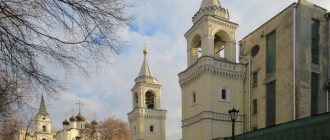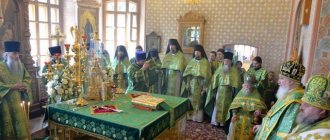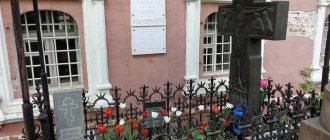Today, thousands of monks and nuns live in Russian monasteries. Some of them came to the monastery out of fear of retribution for sins, some because of a desire to exchange service for heaven, and some simply because of the love of God. At the same time, living life in a monastery is a difficult decision and a great challenge. “Evening Moscow” found out who can go to a monastery, what difficulties he will encounter on the path to God, and also why monasteries are called necropolises.
Why do they leave?
Each person has his own reasons for joining a monastery, said the abbot of the stauropegial New Jerusalem Monastery, Archimandrite Theophylact. But all people, according to him, are united by the love of God, and today there are thousands of them.
- There are as many ways to the kingdom of heaven as there are people. All sorts of people. We have thousands of monasteries, thousands of monastics,” said Theophylact.
Usually people go to a monastery for three reasons. The first is fear. For example, a man lived and sinned, and then he realized that he, a sinner, needed to be saved, and he went to the monastery to repent and cry.
- The second reason is the merchant. That is, you are for me, I am for you. This also happens, and you can’t laugh at it. For example, Lord, I will go to a monastery, and then you will give me heaven. The second step - you also need to go through it - the step of fear, the step of the merchant,” said the interlocutor of “VM”.
The third reason why people go to a monastery is simple. It can be called the step of sonship: just as children unconditionally love their parents, not for the sake of something, so people love God, calling him Father and Creator, who loves man. This step is the most important for the majority of those who go to the monastery.
How to leave
Theophylact said that in order to go to the monastery, you only need a desire. However, the community can only accept adult citizens. First you need to decide in which monastery you would like to live your life. To do this, you should visit five to seven institutions. Of course, men can only consider monasteries, and women can only consider nunneries.
— Let’s say a boy and a girl meet. And it is very important that both parties fall in love with each other and decide to get married. Then there will be marriage. And if only one side loves or wants, but the other does not want, then there will be no marriage. So it is here. Each monastery has its own monastic family, brotherhood or sisterhood. And there it is important that the one who comes wants to stay there, and the other side - those who are there - would want to accept him into their brotherhood or sisterhood,” said Theophylact.
Faithful and Unfaithful
Spaso-Preobrazhensky Solovetsky stauropegial monastery, Arkhangelsk region
There are no volunteer programs on Solovki, but Orthodox men can come as workers from May 1 to September 30. First of all, the monastery needs painters, plasterers, electricians and carpenters. To sign up as a volunteer, you need to arrive as a pilgrim and receive a blessing. Workers live in rooms for 6–10 people with amenities on the floor.
You can get to Solovki from St. Petersburg or Moscow by Murmansk train to Kem station (from 3,000 rubles), and then by ship (1,600 rubles) or by plane from Arkhangelsk (about 6,000 rubles).
solovki-monastyr.ru
How to come as a worker to Valaam
The monastery welcomes working men and women throughout the year.
Including in winter. In order to come to us as a worker, you must fill out a form. If you have already worked with us as a worker, please do not forget to indicate this with a tick in the application form.
Workers are provided with housing on the island, food and transfer by ship from Priozersk and back. They will be able to take free excursions around the monastery and walk around the island in their free time.
What obediences can be assigned
In the Valaam Monastery there are quite a lot of different obediences for workers, we will list some of them: cellar service (washing dishes, working in the refectory, kitchen, warehouses, workshop), gardens, greenhouses, temple, sewing workshop, bakery, boiler rooms, farm etc.
Depending on the period that the worker plans to stay on the island, other obediences may be assigned.
Obediences in the monastery are not chosen according to taste; the distribution of tasks is handled by the Deanery Service.
They usually work in the monastery until 17:00, or in shifts, depending on the assigned obedience. On weekends and free time, additional obediences may be assigned. On Saturday, in many obediences they work until lunch in order to rest before the All-Night Vigil. They usually rest on Sundays and major holidays, as well as on weekends, according to obedience schedules.
Sample daily routine for a worker:
5:00-6:00 - Midnight Office and Six Psalms;
6:00–9:00 — rest/sleep;
9:00 -13:00 - obedience;
13:00—14:00—lunch and rest;
14:00 -17:00 - obedience;
17:00 - 19:00 - evening service (it is blessed to be in the temple for one hour);
19:00 - 21:00 - dinner and free time;
21:00 - 21:40 - evening prayer rule with reading of the Gospel;
21:40 -23:00 - free time;
23:00 - 05:00 - sleep.
Excerpts from “Requirements for Workers”
As workers, we are hired for a period of at least 2 weeks. Workers have the opportunity to live a spiritual life close to monastic life. They can participate in divine services, work together with the monastery brethren, and men can eat in the fraternal refectory.
In the monastery, the worker has the opportunity to strengthen himself in the Christian way of life, to continue the process of his churching through participation in the Holy Sacraments and the entire way of monastic life.
The worker must be an Orthodox Christian or sincerely desire to become one by being Baptized in the Orthodox Church.
The employee must be at least 18 years old and not exceed the pension age.
Due to its island position, the monastery’s ability to accommodate workers is limited. Since there is no permanent hospital on the island with the appropriate medical personnel, equipment and medicines, and due to the fact that for part of the year the island, due to weather and climatic conditions, remains deprived of the possibility of communication with the mainland, the monastery cannot accept those wishing to deal with severe chronic diseases that may need inpatient medical care. Workers engage in strenuous physical labor. Therefore, the monastery primarily accepts workers who do not have physical limitations that prevent them from fulfilling monastic obediences.
What does the monastery provide?
Workers travel at their own expense to the pier in Priozersk. From there they are taken on a monastery ship to Valaam.
Those who come as laborers are accommodated in the “Water House” dormitory, and female laborers are accommodated in the hotel “at the Holy Gates.”
Depending on the length of time the worker stays in the monastery, living conditions may improve.
Free excursions are provided for workers: around the Central Estate with a climb to the bell tower, through the main hermitages, to the museum at the St. Vladimirsky Hermitage, and by ship to the island hermitages. In their free time, workers can walk through the picturesque places of Valaam and relax in nature.
***
It is a tradition to work in a monastery without expecting monetary reward. Someone has the opportunity and donates golden vestments, a barge with grain, a package of socks or an electric kettle to the monastery. Someone gives days of their life, their strength, health, skill. This is a conscious gift, a voluntary sacrifice.
“For the glory of God” is not “for free”, not for food, not for a roof over your head. This is for Love.
Collaboration is a form of spiritual development. This is an opportunity for an Orthodox person to donate his time and energy. The goal of the worker is to grow spiritually, learn humility and love for mankind, and therefore draw closer to God.
Vvedensky Stavropegic Monastery (Optina Pustyn), Kaluga Region
Both adults and children come to Optina Pustyn to work. For 27 years now, an Orthodox children's volunteer camp has been located near the walls of the monastery from mid-June to the end of July. Children live in tents, attend monasteries, stage plays, draw, and participate in competitions. The camp is organized by the Orthodox gymnasium “Radonezh” (gymnasia-radonezh.ru), they transport their students, but also take children from outside to fill the available places.
The easiest way to get there is by car; the road from Moscow will take about four hours (it’s worth making a stop in Kaluga along the way). You can also go by bus to Kozelsk, and from there by minibus. The monastery has different accommodation options: a place in a shared room (200 rubles) or a comfortable room for two (2000 rubles). Applications through the pilgrimage service
optina.ru
Optina Pustyn, according to legend, was founded at the end of the 14th century by a repentant robber named Opta. Photo: Natalia Sidorova / Vostock Photo
Holy Trinity Seraphim-Diveevo Convent, Nizhny Novgorod region
You can come to Diveevo on an excursion, stay in a hotel or private sector and try on the role of a volunteer for a day or two. To do this, you need to take your passport and work clothes (for women - a long skirt, a jacket that covers the elbows, and a scarf) and head to the pilgrimage center. There is always a lot of work, so extra hands definitely won’t hurt. There are 17 pilgrimage corps in the monastery, but it is better to reserve places in advance. Those who do not like large crowds of people should settle in the Ascension monastery, 40 km from the monastery; it has its own pilgrimage building with rooms for one to three people.
The road by car from Moscow - you can make stops in Vladimir, Murom and Arzamas. Another way is by train: starting this summer, the Moscow–Arzamas–Diveevo route has been introduced according to the train+bus scheme, the price one way is 250 rubles.
4udel.nne.ru
The best view of the Seraphim-Diveevo Monastery opens from the Vichkinza River. Photo: Photobank “Lori”
Monk's Vows
Becoming a monk is an irrevocable action; By ceasing the ascetic life after tonsure, a person breaks his connection with God. Dedication to an ascetic life, deep obedience and service to God are the basic principles of life in the monastery.
After tonsure, a monk (nun) takes three vows:
- Chastity. In other words, it is a vow of celibacy and renunciation of lust.
- Obediences. This is a renunciation of one’s will, complete obedience to God and submission, humility with external circumstances.
- Non-covetousness. Refusal of everything earthly in order to subsequently gain lightness of spirit.
In monasticism, the joy of closeness to God is above all, and it replaces all other joys of the world for those who have taken monastic vows.
Holy Intercession Convent, Sverdlovsk region
Verkhoturye is considered the spiritual Orthodox center in the Urals. In addition to the Holy Protection, there is a functioning monastery, several churches and an ancient small Kremlin. The rules are strict: it is proposed to “leave worldly habits and manners behind the fence,” follow the established routine and ask permission in order to go out into the city. You don’t need a special blessing to work, you can just come.
You can get from Yekaterinburg to Verkhoturye by bus (from 800 rubles) or train (from 2500 rubles), the travel time is about five hours.
v-pokrov-m.ru
The Verkhoturye white-stone Kremlin is the only example of a stone fortification in the Middle Urals. Photo: Photobank “Lori”
Trip to the monastery
So, the preparation is completed , the blessing has been received, the monastery has been chosen. Now you should go there to talk with Mother Superior. She will talk about the features of life in the chosen monastery, about traditions and living conditions. You should have the necessary documents with you:
- Passport.
- A short autobiography.
- Marriage certificate or death certificate of spouse (if available).
- Request for admission to the monastery.
You should know that tonsure is permitted only to persons who have reached thirty years of age. If a woman has minor children, she will need to present a certificate of the establishment of guardianship over them by the responsible persons (sometimes they may also require characteristics of the guardians). You need to know that in this case the confessor may not give a blessing for monastic life and the abbess will advise you to stay in the world and raise your children. Staying in the monastery while having a minor child in the world is possible only in exceptional cases. The same applies to situations where a woman has elderly parents who need care.
There is no mandatory deposit of funds, but you can bring a voluntary donation.
Buddhist community Shedrub Ling, Sverdlovsk region
The doors of the only Buddhist monastery in the Urals are open to everyone - tourists, pilgrims and volunteers. The monastery itself is located on the picturesque Mount Kachkanar - in some places harsh and rocky, and in others covered with alpine meadows. The monastery has two stupas, a temple and a library. They also conduct educational courses here, and you can combine business with pleasure: fill gaps in your knowledge of Buddhism and work on the construction of a temple. In the warm season, you can pitch a tent near the monastery; in the cold months, you will have to live in a common room, and spend the night on the floor in sleeping bags.
Getting to Shedrub Ling is not easy. There is a bus from Yekaterinburg to the city of Kachkanar, the travel time is 4.5 hours (from 600 rubles), then you need to follow the exact instructions given on the monastery website (you will have to overcome an 8 km long hike).
shedrub-ling.ru
The authorities periodically threaten to demolish the stupas and houses of the Shedrub Ling community for the sake of developing iron ore deposits, but for now the monastery remains in its place. Photo: Photobank “Lori”
Assumption of the Second Athos Beshtaugorsky Monastery, Stavropol Territory
The monastery on the slope of Beshtau was founded by Athonite monks at the beginning of the twentieth century. Here you can not only work, but also walk along the five-domed mountain, enjoy the views of Pyatigorsk and Mount Mashuk from the slopes, visit the Lermontov Museum and the site of his duel. In recent years, the monastery has been crowded in the summer; in addition to pilgrims and tourists, many children and teenagers come to the “Green Athos” forum. If you want to work in a quiet environment, it is better to go in the fall or spring. To receive a blessing, write to
The monastery is located 10 km from Pyatigorsk, not far from the city of Lermontov. Minibuses and taxis run between settlements, travel time is 15–20 minutes, price is from 35 rubles.
afon-beshtau.ru
The five-domed Beshtau Mountain, after which the city of Pyatigorsk is named, is officially declared a landscape natural monument. Photo: CSP_zhekos / age / East News
Stages of monastic life
The preparatory stages, which various sources include labor and novitiate, do not yet constitute true monasticism. The Monk Macarius of Optina defined its degrees as follows:
- Rasophorus – the degree of beginners;
- mantle – medium level;
- schema – degree of perfection.
The Holy Fathers teach not to strive to receive a mantle or schema as an external image out of a desire to dress in honorable clothes, because this is all from ambition. And for a monk, the main thing is humility. You need to accept the angelic image in your mind. The very acceptance of a small angelic image is a betrothal to the Heavenly Bridegroom Jesus Christ. After a person is dressed in monastic robes during tonsure, he must always have the Name of Jesus on his lips.
Stages of monastic life
The Monk Ambrose of Optina taught to observe the internal and not be afraid of the external. There is no need to desire to receive a ryassophore or a mantle as a means of spiritual growth.
Author's advice
The Monk Nikon taught that a monk should be entirely in God. You can’t go to a monastery just out of a desire to hide from annoying problems. All your thoughts must be revealed to your spiritual father.
If you find an error, please select a piece of text and press Ctrl+Enter.
Ivolginsky datsan, Buryatia
Located 30 km from Ulan-Ude, datsan is the main Buddhist monastery of the CIS. In addition to stupas and temples, there is a university on its territory. Pilgrims and tourists also come here to see the incorruptible body of Hambo Lama Itigelov, who went into nirvana in 1927. The Ivolginsky datsan accepts male volunteers and provides them with the opportunity to live and eat in the monastery. Women can also work, but they will have to stay in the nearest village. Before your trip, you must contact the monastery by phone: +7 (301-40) 2-33-77 (inquiry) or +79834590985 (Tubden Lama).
You can get to the datsan from Ulan-Ude by two minibuses. The first one is for an hour and 45 rubles. will take you to the village of Verkhnyaya Ivolga, the second one in 10 minutes. and 25 rub. - to the monastery.
Temple of the Pure Land in the Ivolginsky datsan Photo: Photobank “Lori”
Required qualities
Going to a monastery - what is needed for this ? A lot is needed, first of all you need to have a number of qualities, namely:
- Sincerely believe in God.
- Have humility and great patience.
- Constantly work on yourself, fighting your own passions, sinful thoughts and vices.
- Give up any bad habits.
- Refusal of any manifestations of worldly vanity.
- Love of prayer.
- Love for your neighbor and all living things.
In addition, it should be borne in mind that nuns are constantly engaged in hard physical labor to earn their living, so it is very desirable to have good physical health and endurance. You will also have to observe fasts and stand at services, which in the monastery last for several hours in a row . Therefore, in addition to physical strength , you also need to have spiritual strength. Each person must first decide for himself whether he can withstand such a life, because removing the monastic rank is very problematic.
Holy Dormition Pskov-Pechersky Monastery, Pskov region
After the publication of Archimandrite Tikhon (Shevkunov’s) book “Unholy Saints,” the monastery is experiencing a new surge in popularity. Although there was no need to complain about the lack of attention before - the proximity of the Pushkin Mountains and Pskov made it part of an exciting tourist route. Due to the influx of people, the time of free stay in the monastery may be limited. Men should contact Monk Maxim (+79113697648), and women should contact the pilgrimage service, +79118902163. You can follow the information on the official page vk.com/pechory.
It is convenient to get there from the Pskov bus station by bus in an hour and 100 rubles.
Haymaking in the Sursky Ioannovsky Monastery.
Photo: Sergey Alekseev
Reasons for renouncing worldly life
The ascetics of ancient times renounced worldly life because it did not attract them. And the chosen deserts and caves were not dark damp graves for them, but a flourishing land of the spirit.
According to Archimandrite Raphael (Karelin), monasticism is a phenomenon that is difficult to understand without internal experience, which is almost impossible to express in words. Modern people do not understand the beauty of monastic life and sometimes wonder why some renounce worldly existence. Monasticism covers the entire spiritual life. It is impossible to understand it without experiencing and feeling it yourself, just as it is difficult to understand love for an unloving heart.
Monk Nicodemus on renunciation of worldly life
The Monk Barsanuphius of Optina compared monasticism to a boundless sea that cannot be crossed. It cannot be understood by a person who has not yet set foot on this path. Father Barsanuphius called the search for God the goal of monastic life. But you can live in a monastery and achieve nothing. Therefore, what is important is not how to get to the monastery, but why.
People take monastic vows in search of continuous communion with God, in search of the Tabor light. Monks are the light of the world. Just externally following the rules and wearing monastic garb does not make a person a monk or nun. Just as a lamp needs fire to shine, so does a person. The Monk Ambrose of Optina wrote that monasticism arose from a person’s desire to live according to the teachings and commandments of the Gospel. This is very difficult to achieve amid worldly worries and bustle. Monasticism is perfect Christianity.
In the teachings of Abba Dorotheus there is a story about the righteous Dositheos. The young man was honored with the appearance of the Mother of God, who told him the conditions necessary for salvation. Their implementation began to confuse the young men around him, and he was advised to go to a monastery. He came to the monastery and repeated to the fathers: “I want to be saved.”
Among men
Before going to a monastery, a man must reveal his thoughts to his spiritual father. Of course, becoming a monk is not a quick process, which is preceded by the novice experience. But after tonsure, nothing can be changed. A person forever makes a series of vows to God and cannot break them.
There may be several reasons why a man wants to become a monk. Often the desire to take monastic vows is confused with the desire to get rid of problems, because sometimes people run to a monastery for the following reasons:
- difficulties in personal and family life;
- difficulties at work, need;
- grief, loss of a loved one, severe stress;
- unhappy love (more typical for young men).
The list of reasons can be supplemented, because this is a purely personal matter. But going to a monastery in order to escape life’s difficulties is not the right path.
Monasticism is perfect Christianity
Among women
There are practically no differences in the reasons for wanting to take tonsure between men and women. But women by nature are more emotional and it is more difficult for them to endure the shocks of worldly life. Living in a monastery is hard work, so it is a mistake to look for peace from difficulties in a nunnery.
The book “Tales of the exploits and events of the life of Elder Seraphim of Sarov” says that Father Seraphim did not bless everyone who asked him for monastic life. The priest advised some to delay taking tonsure, some did not recommend leaving the world at all, and to other women, instead of becoming a nun, he suggested starting a family first.
Sursky Ioannovsky Convent, Arkhangelsk region
The tiny monastery, where five sisters now live permanently, is in dire need of help. By some miracle, these brave women manage a large farm - several fields, two cows, a calf and chickens. Mother Mitrofania writes about this with genuine sincerity on the monastery’s website. In addition to agricultural activities, the restoration of a monastery destroyed during the Soviet years and the construction of a House of Mercy for widowed priests are underway here.
They get to Sura by train - first to Arkhangelsk, then by train to Karpogory, and from there by car, which mother can send. In addition to work and communication with sisters, workers will get to know the nature of the northern region, a real break from civilization and, if they arrive at the beginning of summer, white nights.
sura-monastery.ru
Basic Rules
First of all, you need to understand that no one will allow you to become a novice for one church ceremony. It may take several years to prove to other clergy his devotion to the ideas of religion and asceticism. During this time, a person is completely immersed in the religious cultural space, which allows him to build stronger and more exalted relationships with the Lord. However, if you follow some rules, you can receive the rank of novice within one calendar year, which is very little by church standards:
- Attend services and go to confession regularly. If, for example, getting up early for Sunday services tires you, you should once again reconsider your desire to devote yourself to the church. We must remember that the rank of novice is directly related to the renunciation of one’s own comfort, full service to God and the search for truth in faith;
- Agree with someone from the monastery leadership about becoming a worker; now you can do this online. A laborer is a person who helps with household work and acts on instructions from monks and novices. Such people do not have strictly standardized work hours, everything is decided on an individual basis, for example, some come to work annually, for several weeks, thereby people find physical and spiritual cleansing. But this is how you can test how ready you are for hard work on a regular basis;
- Write a request to be accepted as a novice at the monastery. It must be sent to the rector. If approved, you will have the right to wear specific religious symbols, but you will still have your secular name and the right to return to secular life.
The next step after novitiate is the adoption of monasticism. However, you need to approach such a step with all responsibility. Don’t rush yourself; remember also that the Lord is guiding you in finding your religious path. And if you were refused tonsure or even novitiate, it would be better for you and for the church community.











